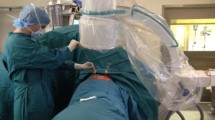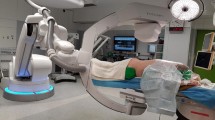Abstract
Kyphoplasty (KP) is a minimally invasive technique for the percutaneous stabilisation of vertebral fractures. As such, this technique is highly dependent upon intraoperative fluoroscopic visualisation. In order to assess the range of radiation doses that patients are typically subjected to, 60 consecutive procedures using simultaneous bilateral fluoroscopy were analysed with respect to exposure time (ET). In a subset of 16 of these patients, a theoretical entrance skin dose (ESD) and effective dose was additionally calculated from intraoperatively measured dose area product. Average fluoroscopy time for single level cases reached 2.2 min (range 0.6–4.3) in the lateral plane and 1.6 min (range 0.5–3.0) in the anterior–posterior plane. For multiple level cases the corresponding ET per level was 1.7 min (range 0.6–2.9) per level in the lateral and 1.1 min (range 0.5–2.0) in the anterior-posterior plane. ESD was estimated as an average 0.32 Gy (range 0.05–0.86) in the anterior–posterior and 0.68 Gy (range 0.10–1.43) in the lateral plane. Effective dose (cumulative from both planes) averaged 4.28 mSv (range 0.47–10.14). Safety margins for the development of early transient erythema are respected within the presented fluoroscopy times. Longer ET in the lateral plane may however breach the 2 Gy threshold. Use of large c-arms and judiciously operating the exposure is recommended. With regard to effective dose, a single fluoroscopy guided KP performed for osteoporotic or traumatic vertebral fractures is a safe procedure.



Similar content being viewed by others
References
Boszczyk BM, Bierschneider M, Hauck S, Vastmans J, Potulski M, Beisse R, Robert B, Jaksche H (2004) Kyphoplastik im konventionellen und halboffenen Verfahren. Orthopäde 33:13–21
Brugieres P, Gaston A, Heran F, Voisin MC, Marsault C (1990) Percutaneous biopsies of the thoracic spine under CT guidance: transcostovertebral approach. J Comput Assist Tomogr 14:446–448
Galansky M, Nagel HD, Stamm G (2001) CT-Expositionspraxis in der Bundesrepublik Deutschland, Fortschritte auf dem Gebiet der Röntgenstrahlen und bildgebenden Verfahren. RöFo 173:R1-R66
Garfin SR, Hansen AY, Reiley MA (2001) Kyphoplasty and vertebroplasty for the treatment of painful osteoporotic compression fractures. Spine 26:1511–1515
Harrison RM (1982) Backscatter factors for diagnostic radiology. Phys Med Biol 27:1465–1474
Harstall R, Heini PF, Mini RL, Orler R (2005) Radiation exposure to the surgeon during fluoroscopically assisted percutaneous vertebroplasty—a prospective study. Spine (in press)
International Commission on Radiological Protection (1991) 1990 Recommendations of the International Commission on Radiological Protection. ICRP Publication 60, Pergamon Press, Oxford
Kallmes DF, O E, Roy SS, Piccolo RG, Marx WF, Lee JK, Jensen ME (2003) Radiation dose to the operator during vertebroplasty: prospective comparison of the use of 1-cc syringes versus an injection device. Am J Neuroradiol 24:1257–1269
Kruger R, Faciszewski T (2003) Radiation dose reduction to medical staff during vertebroplasty: a review of techniques and methods to mitigate occupational dose. Spine 28:1608–1613
Le Heron JC (1992) Estimation of effective dose to the patient during medical X-ray examinations from measurement of the dose-area product. Phys Med Biol 37:2117–2126
Mehdizade A, Lovblad KO, Wilhelm KE, Somon T, Wetzel SG, Kelekis AD, Yilmaz H, Abdo G, Martin JB, Viera JM, Rüfenacht DA (2004) Radiation dose in vertebroplasty. Neuroradiology 46:243–245
Perisinakis K, Damilakis J, Theocharopoulos N, Papadokostakis G, Hadjipavlou A, Gourtsoyiannis N (2004) Patient exposure and associated radiation risks from fluoroscopically guided vertebroplasty or kyphoplasty. Radiology 232:701–707
Petoussi-Henss N, Zankl M, Drexler G, Panzer W, Regulla D (1998) Calculation of backscatter factors for diagnostic radiology using Monte Carlo methods. Phys Med Biol 43:2237–2250
Theocharopoulos N, Perisinakis K, Damilakis J, Papadokostakis G, Hadjipavlou A, Gourtsoyiannis N (2003) Occupational exposure from common fluoroscopic projections used in orthopaedic surgery. J Bone Joint Surg 85-A:1698–1703
Wagner LK, Eifel PJ, Geise RA (1994) Potential biological effects following high X-ray dose interventional procedures. J Vasc Interv Radiol 5:71–84
Acknowledgements
Figure 1 was provided through courtesy of Spinegraphics.
Author information
Authors and Affiliations
Corresponding author
Additional information
Sources of support: No financial support was received for this investigation.
Rights and permissions
About this article
Cite this article
Boszczyk, B.M., Bierschneider, M., Panzer, S. et al. Fluoroscopic radiation exposure of the kyphoplasty patient. Eur Spine J 15, 347–355 (2006). https://doi.org/10.1007/s00586-005-0952-0
Received:
Revised:
Accepted:
Published:
Issue Date:
DOI: https://doi.org/10.1007/s00586-005-0952-0




